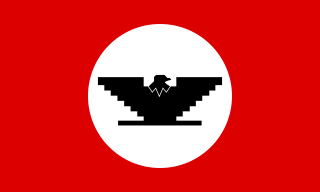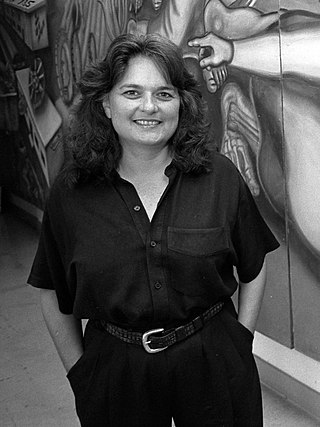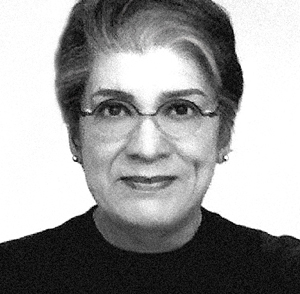Related Research Articles

Estrada Courts is a low-income housing project in the Boyle Heights area of Los Angeles, California. It is located on E. Olympic Blvd & S. Lorena st.
Harry Gamboa Jr. is an American Chicano essayist, photographer, director, and performance artist. He was a founding member of the influential Chicano performance art collective ASCO.

Kent Twitchell is an American muralist who is most active in Los Angeles. He is most famous for his larger-than-life mural portraits, often of celebrities and artists. His murals are realism not photorealism according to Twitchell.

Los Four was a Chicano artist collective active based in Los Angeles, California. The group was instrumental in bringing the Chicano art movement to the attention of the mainstream art world.

Judith Francisca Baca is an American artist, activist, and professor of Chicano studies, world arts, and cultures based at the University of California, Los Angeles. She is the co-founder and artistic director of the Social and Public Art Resource Center (SPARC) in Venice, California. Baca is the director of the mural project that created the Great Wall of Los Angeles, which was the largest known communal mural project in the world as of 2018.

Helen Lundeberg (1908–1999) was an American painter. Along with her husband Lorser Feitelson, she is credited with establishing the Post-Surrealist movement. Her artistic style changed over the course of her career, and has been described variously as Post-Surrealism, Hard-edge painting and Subjective Classicism.
RISK, also known as RISKY, is a Los Angeles–based graffiti writer and contemporary artist often credited as a founder of the West Coast graffiti scene. In the 1980s, he was one of the first graffiti writers in Southern California to paint freight trains, and he pioneered writing on "heavens", or freeway overpasses. He took his graffiti into the gallery with the launch of the Third Rail series of art shows, and later created a line of graffiti-inspired clothing. In 2017, RISK was knighted by the Medici Family.

John Wehrle is an American artist currently living in Richmond, California. Wehrle is best known as a muralist and site-specific installation artist, predominantly active in California. Proficient in painting, sculpture and photography, his work is in public and private collections. Several of his exterior mural works, Fall of Icarus, Positively Fourth Street, and Galileo Jupiter Apollo achieved underground iconic status during their existence. Wehrle's interior murals and surviving installations have been internationally collected.

Alma López is a Mexican-born Queer Chicana artist. Her art often portrays historical and cultural Mexican figures, such as the Virgin of Guadalupe and La Llorona, filtered through a radical Chicana feminist lesbian lens. Her art work is meant to empower women and indigenous Mexicans by the reappropriation of symbols of Mexica history when women played a more prominent role. The medium of digital art allows her to mix different elements from Catholicism and juxtapose it to indigenous art, women, and issues such as rape, gender violence, sexual marginalization and racism. This juxtaposition allows her to explore the representation of women and indigenous Mexicans and their histories that have been lost or fragmented since colonization. Her work is often seen as controversial. Currently, she is a lecturer at the University of California Los Angeles in the Department of Chicana/o Studies.

Judithe Hernández is an American artist and educator, she is known as a muralist, pastel artist, and painter. She is a pioneer of the Chicano art movement and a former member of the art collective Los Four. She is based in Los Angeles, California and previously lived in Chicago.
Willie F. Herrón III is an American Chicano muralist, performance artist and commercial artist.

Alonzo Davis is an African-American artist and academic known for co-founding the Brockman Gallery in Los Angeles with his brother Dale Brockman Davis. In reaction to a perceived lack of coverage of black art, Davis became an advocate for black art and artists. His best-known work is the Eye on '84 mural he painted to commemorate the 1984 Summer Olympics.
Barbara Carrasco is a Chicana artist, activist, painter and muralist. She lives and works in Los Angeles. Her work critiques dominant cultural stereotypes involving socioeconomics, race, gender and sexuality, and she is considered to be a radical feminist. Her art has been exhibited nationally and internationally. Her work was exhibited in the 1990-1993 traveling exhibition Chicano Art: Resistance and Affirmation.

Johanna Poethig is an American Bay Area visual, public and performance artist whose work includes murals, paintings, sculpture and multimedia installations. She has split her practice between community-based public art and gallery and performance works that mix satire, feminism and cultural critique. Poethig emerged in the 1980s as socially engaged collaborations with youth and marginalized groups gained increasing attention; she has worked as an artist and educator with diverse immigrant communities, children from five to seventeen, senior citizens, incarcerated women and mental health patients, among others. Artweek critic Meredith Tromble places her in an activist tradition running from Jacques-Louis David through Diego Rivera to Barbara Kruger, writing that her work, including more than fifty major murals and installations, combines "the idealist and caustic."
Patricia "Pat" Gomez is a Chicana visual artist based in Los Angeles best known for incorporating text within her art. She is currently the Civic Art Project Manager at Los Angeles County Department of Arts and Culture.
Lucila Villaseñor Grijalva is a Chicana muralist who was born in Los Angeles, California. Her art style is inspired by graffiti art.
Kristy Sandoval is a Xicana muralist based out of the Northeast San Fernando Valley of Los Angeles, California.
Graciela Carrillo is a Chicana artist and muralist in San Francisco and member of the all-female Chicana/Latina artist group Mujeres Muralistas. She is a co-founder of Galería de la Raza, a gallery utilized to showcase the everyday lives of the Chicano community through art during the Chicano Civil Rights movement through the Chicano muralist movement.

Greater Los Angeles, California, is home to thousands of murals, earning it the nickname "the mural capital of the world" or "the mural capital of America." The city's mural culture began and proliferated throughout the 20th century. Murals in Los Angeles often reflect the social and political movements of their time and highlight cultural symbols representative of Southern California. In particular, murals in Los Angeles have been influenced by the Chicano art movement and the culture of Los Angeles. Murals are considered a distinctive form of public art in Los Angeles, often associated with street art, billboards, and contemporary graffiti.
Terry Schoonhoven (1945-2001) was an American muralist, lithographer, and painter. Interested in the environment, architecture, film, history, geography, and the fluidity of time, he painted more than 40 large scale public murals over the course of his career, including six as co-founder of the LA Fine Arts Squad. His work -- "terrifying by the intensity of its reality and powerful associative qualities"—often explored dystopic environmental themes.
References
- ↑ Black, Lisa (11 July 2019). "'Self-Help Graphics: 1983-1991' at Laguna Art Museum Looks Brand-New". OC Weekly. Archived from the original on 11 November 2019. Retrieved 17 September 2019.
- ↑ Reilly, Sue (3 January 1991). "Purple Cows Muralist Glenna Avila believes in purple..." Los Angeles Times. Retrieved 18 September 2019.
- ↑ Gelt, Jessica (20 August 2014). "L.A. again carries a torch for 1984 Olympic murals, their artists". Los Angeles Times. Archived from the original on 29 November 2019. Retrieved 17 September 2019.
- ↑ Plummer, Mary (28 July 2014). "New CalArts residency transforms artists into teachers". Southern California Public Radio. Archived from the original on 26 January 2021. Retrieved 17 September 2019.
- ↑ "Plumas Para Paloma". Calisphere. Retrieved 18 September 2019.
- 1 2 3 4 Lipschitz, Pancho (2016). "Profile: LA Mural Visionary Glenna Avila". Brooklyn & Boyle. Archived from the original on 2019-06-07.
- 1 2 3 "Los Angeles Murals". www.publicartinla.com. Archived from the original on 2019-06-07. Retrieved 2019-06-06.
- ↑ Avila, Glenna (1 March 2016). "Community Arts Practice: The First Arts Practice in the World". Radical Actions. Archived from the original on 7 June 2019.
- ↑ "Los Angeles Olympic Murals (The Restoration of Glenn Avila's LA Freeway Kids)". Youtube. 12 Dec 2012.
- ↑ Igoe, Kim; Roosa, Alexandra (2002). "Listening to the Voices in Our Communities". The Journal of Museum Education. 27 (2/3): 16–21. doi:10.1080/10598650.2002.11510464. JSTOR 40479252. S2CID 146856665.
- ↑ "Uncovered Olympic Glories: Murals Restoration on the 101 Freeway". 23 May 2013. Archived from the original on 19 September 2020. Retrieved 16 April 2020.